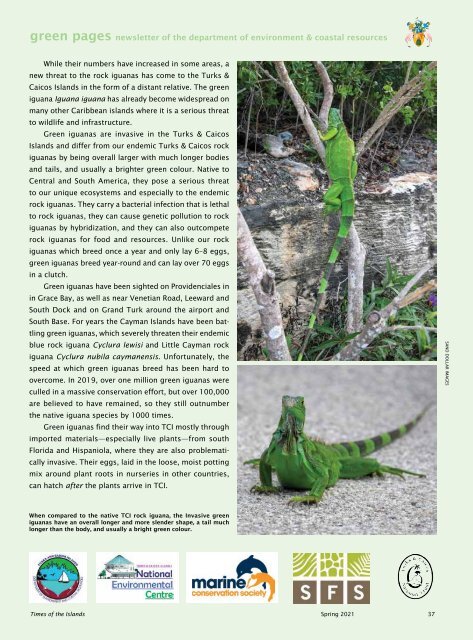Times of the Islands Spring 2021
Presents the "soul of the Turks & Caicos Islands" with in-depth features about local people, culture, history, environment, real estate, businesses, resorts, restaurants and activities.
Presents the "soul of the Turks & Caicos Islands" with in-depth features about local people, culture, history, environment, real estate, businesses, resorts, restaurants and activities.
Create successful ePaper yourself
Turn your PDF publications into a flip-book with our unique Google optimized e-Paper software.
green pages newsletter <strong>of</strong> <strong>the</strong> department <strong>of</strong> environment & coastal resources<br />
While <strong>the</strong>ir numbers have increased in some areas, a<br />
new threat to <strong>the</strong> rock iguanas has come to <strong>the</strong> Turks &<br />
Caicos <strong>Islands</strong> in <strong>the</strong> form <strong>of</strong> a distant relative. The green<br />
iguana Iguana iguana has already become widespread on<br />
many o<strong>the</strong>r Caribbean islands where it is a serious threat<br />
to wildlife and infrastructure.<br />
Green iguanas are invasive in <strong>the</strong> Turks & Caicos<br />
<strong>Islands</strong> and differ from our endemic Turks & Caicos rock<br />
iguanas by being overall larger with much longer bodies<br />
and tails, and usually a brighter green colour. Native to<br />
Central and South America, <strong>the</strong>y pose a serious threat<br />
to our unique ecosystems and especially to <strong>the</strong> endemic<br />
rock iguanas. They carry a bacterial infection that is lethal<br />
to rock iguanas, <strong>the</strong>y can cause genetic pollution to rock<br />
iguanas by hybridization, and <strong>the</strong>y can also outcompete<br />
rock iguanas for food and resources. Unlike our rock<br />
iguanas which breed once a year and only lay 6–8 eggs,<br />
green iguanas breed year-round and can lay over 70 eggs<br />
in a clutch.<br />
Green iguanas have been sighted on Providenciales in<br />
in Grace Bay, as well as near Venetian Road, Leeward and<br />
South Dock and on Grand Turk around <strong>the</strong> airport and<br />
South Base. For years <strong>the</strong> Cayman <strong>Islands</strong> have been battling<br />
green iguanas, which severely threaten <strong>the</strong>ir endemic<br />
blue rock iguana Cyclura lewisi and Little Cayman rock<br />
iguana Cyclura nubila caymanensis. Unfortunately, <strong>the</strong><br />
speed at which green iguanas breed has been hard to<br />
overcome. In 2019, over one million green iguanas were<br />
culled in a massive conservation effort, but over 100,000<br />
are believed to have remained, so <strong>the</strong>y still outnumber<br />
<strong>the</strong> native iguana species by 1000 times.<br />
Green iguanas find <strong>the</strong>ir way into TCI mostly through<br />
imported materials—especially live plants—from south<br />
Florida and Hispaniola, where <strong>the</strong>y are also problematically<br />
invasive. Their eggs, laid in <strong>the</strong> loose, moist potting<br />
mix around plant roots in nurseries in o<strong>the</strong>r countries,<br />
can hatch after <strong>the</strong> plants arrive in TCI.<br />
SAND DOLLAR IMAGES<br />
When compared to <strong>the</strong> native TCI rock iguana, <strong>the</strong> Invasive green<br />
iguanas have an overall longer and more slender shape, a tail much<br />
longer than <strong>the</strong> body, and usually a bright green colour.<br />
<strong>Times</strong> <strong>of</strong> <strong>the</strong> <strong>Islands</strong> <strong>Spring</strong> <strong>2021</strong> 37

















